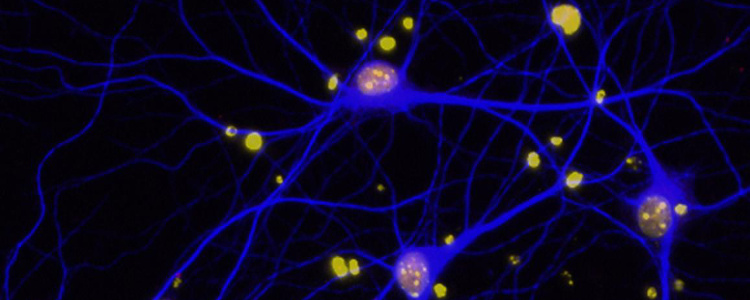Magneto Protein Could Help Magnets Control Brain Circuitry

This image shows mouse neurons in a dish, from an NIH study not described in this story.
(Inside Science) -- Genetic engineering can now help researchers use magnets to control nervous systems. Scientists have successfully controlled the behavior of zebrafish and mice with this research, and suggest that one day it might help treat brain disorders in people.
In the past decade or so, scientists have devised a way to control brain activity with lasers. This strategy, called optogenetics, uses viruses to insert genes into cells and make them sensitive to light coming from the lasers. Optogenetics has revolutionized neuroscience by giving researchers a precise way to excite or suppress neural circuits and shed light on what role they play in the brain.
Optogenetics possesses a number of advantages over previous methods of controlling neurons. For instance, electrical pulses stimulate all the neurons in a spot in the brain, not just desired cell types, while drugs act slowly. However, optogenetics has a number of drawbacks of its own. Light cannot penetrate deep past the skull or into the brain, so optogenetics typically requires invasive surgery to implant optical fibers near whatever neural circuits scientists want to illuminate.
Now neuroscientist Ali Güler, at the University of Virginia in Charlottesville, and his colleagues have developed a genetic construct they named "Magneto" that can be inserted into neurons to make them sensitive to magnetic fields. They said their work achieved the first example of magnetic control of the nervous system using genetic engineering. The researchers detailed their findings online March 7 in the journal Nature Neuroscience.
The scientists based their design on a molecule known as TRPV4, a protein that can let calcium ions into cells. Calcium ions can help trigger nerve impulses.
Prior work found that TRPV4 can respond to pressure. Güler and his colleagues fused the gene for rat TRPV4 to a gene for human ferritin, a protein that stores iron. The researchers suspected that when a magnetic field was applied to this genetic construct, the ferritin would move, tugging TRPV4 open.
In experiments, scientists injected Magneto into sensory neurons in the spinal cords of zebrafish, a Himalayan fish commonly used in labs. When these zebrafish were placed between strong rare earth magnets, the magnetic fields triggered escape responses, making their bodies coil 10 times more often than zebrafish without Magneto.
"Anything that the animal with Magneto feels and does and perhaps thinks can be remote controlled by magnetic fields," said clinical neurologist and scientist-physician Wolfgang Liedtke at Duke University in Durham, North Carolina, who did not take part in this research.
The researchers also experimented with mice, targeting the striatum, a region located deep within the brain that is challenging to manipulate with optogenetics. The striatum is a key part of the brain's reward circuitry, and the scientists found that mice with Magneto significantly preferred magnetized spots in a chamber over nonmagnetic ones.
"We activated the pleasure or reward pathway that food or drugs would activate," Güler said.
One virtue of "magnetogenetics" is that, like optogenetics, it can target very specific parts of the brain. However, magnetogenetics can penetrate deeper into the brain than optogenetics, and can in principle also easily influence broad regions of the brain simultaneously, whereas optogenetics can only stimulate whatever spot an optical fiber can illuminate, Güler said.
One disadvantage of Magneto so far is that it also responds to a number of factors known to activate TRPV4, such as heat or naturally occurring brain compounds. The scientists are now working to make Magneto respond only to magnetic fields, as well as increase its responsiveness to magnetic fields, Güler said.
Güler noted that magnetogenetics could one day work alongside optogenetics and other approaches.
"You could combine multiple techniques to control several separate neural circuits at the same time," Liedtke said.
One day magnetogenetics could even help treat brain disorders, Güler said. Gene therapy can introduce helpful genes into neurons, and magnets could control specific neural circuits when needed.
"Optogenetic manipulation of neural circuits in patients has huge drawbacks — you'd need to implant a fiber-optic cable in them for it to work," said Liedtke, who helped discover TRPV4. "With Magneto, you could just put a magnetic field against the skull."
Gene therapy clinical trials have experienced problems with safety and efficacy over the decades. Still, "there are many researchers who are fine-tuning these things so that one day we can use viral gene therapy safely in humans," Güler said.

